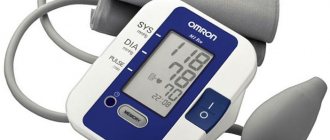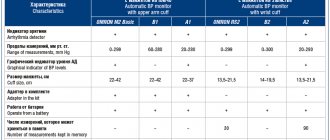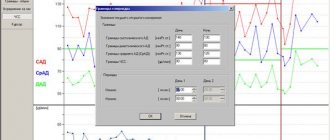OMRON is a famous Japanese company that is widely known these days for its high-tech electronics innovations. But its main know-how concerns medical equipment. Thus, OMRON is rightfully considered a company that produces the highest quality inhalers (nebulizers) and blood pressure monitors. And today we will talk specifically about blood pressure monitors from OMRON for home use. There is one more important point. OMRON not only strives to improve devices for measuring blood pressure, but also reduces their cost as much as possible, without sacrificing quality. As a result, OMRON tonometers have virtually no competitors, are characterized by excellent parameters and affordable prices. And all this does not leave users indifferent.
What types of OMRON blood pressure monitors are there?
It has long been known that the first models of tonometers for home use were mechanical. The instruments consisted of a cuff, a bulb for pumping air, a pressure gauge with a scale, and a stethoscope, which was used to listen to the beats of the upper and lower (systolic and diastolic) pressure. But using such devices is not always convenient. Especially if you measure your own blood pressure. But most often this is what happens: a person suffering from high blood pressure is at home, and all his household members are at work or school. That is why OMRON suggests not wasting your time on mechanical blood pressure monitors and paying attention to automatic devices.
After all, they have many advantages from the users’ point of view:
- Nowadays, automatic tonometer models have become much more accurate, since they use a number of simultaneous measurements to derive the final blood pressure reading;
- equipped with a function to check the correct application of the device cuff;
- equipped with pulse counting and arrhythmia detection functions;
- equipped with a memory function for the last few pressure measurements;
- have the function of switching the operating mode of the device, for example, “guest” mode, etc.
OMRON currently offers automatic models of tonometers for the upper arm and wrist.
Measurement results and accuracy
- My doctor says that electronic devices are not accurate and that only a doctor and an experienced nurse can measure my blood pressure correctly. How accurate is the result when measuring pressure with a Microlife tonometer?
- When measuring blood pressure with Microlife electronic blood pressure monitors, I expect to get the same result, but every time I get different results. Does this mean that the device is faulty?
- My doctor says my blood pressure is 150 over 100 mmHg, then why does the Microlife device give me a result of 135 over 95 mmHg?
- I understand that the pressure changes throughout the day and therefore I get different results. How can I find out my real blood pressure in this case?
- Before I bought the Microlife tonometer, I used a tonometer from another manufacturer. Why do I get different results when measuring blood pressure with the Microlife device?
- How do I know if the device's readings are accurate after using it for a long time or if it has been dropped?
- Why and when should I test my instrument for accuracy?
- Which tonometer is more accurate - wrist or shoulder?
- I have a Microlife wrist tonometer and a Microlife shoulder tonometer. Why are their readings different?
- Is the accuracy of a manual device comparable to that of an automatic one?
- 11. When measuring pressure with a Microlife tonometer, the systolic pressure coincides with the value determined by the doctor, why the diastolic pressure is 10 mm Hg. higher than determined by the doctor?
- I take several measurements in a row at home with the Microlife device, why, starting from about the fifth measurement, do I get significantly lower readings?
- Can you be sure that the Microlife device readings are correct when measuring blood pressure during pregnancy?
My doctor says that electronic devices are not accurate and that only a doctor and an experienced nurse can measure my blood pressure correctly. How accurate is the result when measuring pressure with a Microlife tonometer?
- Microlife electronic blood pressure monitors measure blood pressure using the so-called oscillometric method. This method has been internationally recognized for more than thirty years and is widely used in medical institutions when it is necessary to determine blood pressure levels with high accuracy. The pressure oscillogram analyzed using this method during deflation of the cuff provides the most accurate results.
- Microlife has been involved in human body signal research and accurate blood pressure measurement for many years. The correctness of the chosen technique is confirmed by independent clinical studies conducted according to international standards.
- It should be noted that the high accuracy of measurements with electronic devices is guaranteed by the fact that they make it possible to carry out measurements at home, when the patient is in a calm and relaxed state.
- Most doctors and nurses, of course, prefer a stethoscope because this method gives them the ability to hear the body's signals and gain deeper insight into their patient's health. But electronic tonometers eliminate situations where doctors are uncertain about the correctness of the results, which arises in cases where they are unable to clearly trace the body’s signals.
- “Medical measurement” of pressure not only includes the human factor, but also does not allow the patient, who is in an unusual environment, to completely relax.
- It is known that the deflation of air from the cuff should occur at a slow pace, at a speed of 2 mm Hg. Art. per second. This is a necessary condition for obtaining accurate results during medical measurements. But this condition is often violated because doctors and nurses use high air deflation rates, which leads to inaccurate measurement results.
- The most convincing fact speaking in favor of electronic tonometers is the recommendations of the most authoritative experts in the field of blood pressure, who call for regular measurements at home, and not in the doctor’s office, since such measurements are only occasional.
- Electronic tonometers provide the opportunity for frequent measurements, they are simple and very convenient. There is nothing special about the fact that the magnitude of the measurement results is different. If a doctor took measurements several times in a row - which, however, he never does - then the results of his measurements would also be different.
When measuring blood pressure with Microlife electronic blood pressure monitors, I expect to get the same result, but every time I get different results. Does this mean that the device is faulty?
- Blood pressure levels are not constant. For various physiological reasons, readings may fluctuate by +/- 30 mmHg over a very short period of time. Therefore, measurement values can vary from one measurement to another. It is practically impossible to maintain the same measurement conditions for each individual sequential measurement. Naturally, different values are obtained due to the instability of the psychological state and external factors (conversations, noise, movement, etc.)
- Therefore, in order to find out your blood pressure level, it is necessary to determine the average value of several measurements that need to be taken over several days, in the same environment, at the same time of day. Try to measure your blood pressure three days in a row, for example, an hour after dinner, and you will see that the difference in the measurement values will be insignificant. The average of these measurements best reflects your blood pressure levels.
My doctor says my blood pressure is 150 over 100 mmHg, why does the Microlife device give me a result of 135 over 95 mmHg?
- You may feel less relaxed in the doctor's office than at home. When you are nervous, your blood pressure rises. In a calm environment, systolic pressure decreases by 15 mmHg. Art., which is normal.
- Blood pressure levels fluctuate throughout the day. Pressure change within +/-30 mm Hg. Art. occur over even a short period of time, in connection with various activities (sports, mental activity, due to stress, abdominal pain, etc.).
- We recommend measuring your blood pressure at the same time of day, in the same environment, for example, every evening, an hour after dinner.
- Each manufacturer differs from the other in its methodology for identifying blood pressure. The “methodology” of the measuring device and the doctor also differ. This difference is comparable to the situation when two doctors, using each stethoscope, measure the pressure of the same patient, but get different values.
I understand that the pressure changes throughout the day and therefore I get different results. But how can I find out my real pressure in this case?
- The average value of several measurements taken several days in a row, in the same environment, at the same time of day, is an individual indicator of blood pressure.
- Try to measure your blood pressure three days in a row, for example, an hour after dinner, and you will see that the difference in the measurement values will be insignificant. The average of these measurements best reflects your blood pressure levels.
Before I bought the Microlife tonometer, I used a tonometer from another manufacturer. Why do I get different results when measuring blood pressure with the Microlife device?
- Most electronic tonometers operate using the so-called oscillometric measurement method. Each manufacturer adheres to its own methods for analyzing signals and determining the values of systolic and diastolic pressure. Significant differences in instrument accuracy have been demonstrated in a number of clinical trials.
- Microlife has been involved in human body signal research and accurate blood pressure measurement for many years. The correctness of the chosen technique is confirmed by independent clinical studies conducted according to international standards.
- Each manufacturer uses its own methodology, which is subsequently optimized for the “standard” population. There may be categories of people for whom one device is better suited than another; similarly, two doctors with different skills in using stethoscopes may obtain different measurement results.
- Another reason for differences in readings is changes in pressure between measurements. It is practically impossible to maintain the same measurement conditions for several successive measurements. Naturally, different values are obtained due to the instability of the psychological state and external factors (conversations, noise, movement, etc.)
- To compare two measurement techniques, it is necessary to exclude the influence of any external factors. The measurement must be carried out in the complete absence of external stimuli, and in strict accordance with the manufacturer's instructions. Each subsequent measurement should take place in a similar environment and at the same time of day. Rest between measurements is required, the interval should be at least 3 minutes. Take several measurements with each instrument and compare the average measurements. Only by strictly following the above instructions can you find out the magnitude of the differences between devices from different manufacturers.
How do I know if the device's readings are accurate after using it for a long time or if it has been dropped?
- If the device works after being dropped, it continues to show correct results. The main components that determine the accuracy of the readings are the electrical circuit board and pressure sensor, which may not work after a strong fall. The remaining parts of the device, such as the release valve or the compressor, are reliably protected from any damage during falls or from wear. Therefore, if such situations arise, we recommend contacting a service center to check the accuracy of the device.
- In any case, in accordance with international standards, we recommend testing your device for accuracy every two years. To do this, contact Microlife service centers.
Why and when should I test my instrument for accuracy?
- Microlife instruments are designed in such a way that their accuracy is maintained over a long service life. To guarantee this accuracy, we recommend - in accordance with international standards - to have the instrument's accuracy checked every two years by an authorized Microlife representative.
Which tonometer is more accurate - wrist or shoulder?
- Both models have comparable accuracy. However, each person has his own structural features of blood vessels and tissues, and therefore each of these devices has its own advantages for different types of people.
- It also happens that for some people the signals on the wrist are very weak, so when measuring pressure with wrist devices, the error signal “Error“ may be displayed.
- Wrist pressure measurements are very sensitive to body movements. Therefore, we recommend that you do not move your hand during measurement.
- It is important that the cuff is at heart level during measurement. For wrist tonometers, this is a common mistake that leads to inaccurate results. Even 10 cm above the level of the heart leads to a result that is 8 mm Hg lower. Art., and 10 cm below the level of the heart - to a result greater by 8 mm Hg. Art.
- Measuring pressure with wrist devices is much easier and faster than with shoulder tonometers, so they are carried out much more often. Because blood pressure varies throughout the day, it is important to take as many measurements as possible. Wrist tonometers allow you to measure blood pressure on the road and in any other conditions where it is difficult to use a brachial tonometer.
- Wrist blood pressure monitors are not recommended for people with severe atherosclerosis. With age, the ligamentous apparatus in the wrist becomes denser, which makes it difficult to obtain a reliable result (the level of blood pressure measured at the wrist will be lower than at the brachial level).
I have a Microlife wrist tonometer and a Microlife shoulder tonometer. Why are their readings different?
- Both models have comparable accuracy. However, each person has his own structural features of blood vessels and tissues, and therefore, for different types of people, each type of device has its own advantages.
- It is very important that the cuff is positioned at heart level when taking measurements. It is quite difficult to comply with this condition when measuring pressure with wrist devices. Even 10 cm above the level of the heart leads to a result that is 8 mm Hg lower. Art., and 10 cm below the level of the heart - to a result greater by 8 mm Hg. Art.
- Some people have very weak wrist signals, so an error signal is displayed very often when taking measurements.
- It is possible to reliably assess your blood pressure using a wrist tonometer by taking into account the difference in indicators with a brachial tonometer.
- If you are measuring the pressure on your wrist, you must follow all instructions very strictly and do not move during the measurement, as the devices are very sensitive to movement.
- Since there are many individual factors, it is recommended to compare two models and choose the one that gives the most consistent results. If you get completely different measurements, we recommend using the shoulder model.
Is the accuracy of a manual device comparable to that of an automatic one?
- Both systems have the same accuracy. Automatic blood pressure monitors have a built-in electric pump, while manual ones have a bulb for inflating the cuff, but this does not affect the accuracy.
When measuring pressure with a Microlife tonometer, the systolic pressure coincides with the value determined by the doctor, which is why the diastolic pressure is 10 mm Hg. higher than determined by the doctor?
- Diastolic pressure is very difficult to determine using a stethoscope and the accuracy of the determination depends only on the ability of the doctor. Correlating diastolic pressure is more difficult than systolic pressure.
I take several measurements in a row at home with the Microlife device, why, starting from about the fifth measurement, do I get significantly lower readings?
- The reason is blood stagnation resulting from too short intervals between measurements. It is also strongly recommended to remove the cuff between measurements.
Can you be sure that the Microlife device readings are correct when measuring blood pressure during pregnancy?
- Yes, Microlife devices have received the necessary certification for measuring blood pressure during pregnancy and preeclampsia. About 20% of women have high blood pressure during pregnancy, which can have a negative effect on the fetus and cause a condition called eclampsia. Therefore, if your blood pressure increases during pregnancy, you should consult a doctor.
OMRON shoulder blood pressure monitors
Automatic tonometers for the upper arm are very easy to operate - just press one button.
In less than a minute, the result is displayed. It is worth noting that, in addition to the blood pressure indicators themselves, such a device can calculate the pulse. And also identify the presence of arrhythmia in the user. Modern machines are not connected to the network; they use batteries to operate.
Leaders of the TOP rating of the best models of automatic tonometers for the shoulder
The corresponding leader in recent years can be called OMRON M2 Basic HEM 7121 –ALRU.
This tonometer is notable:
- fan-shaped cuff;
- the intellisense system, which takes into account the pressure and condition of the users’ blood vessels, selecting the necessary filling of the cuff when inflating;
- taking the average result from a series of measurements so that the final blood pressure reading is as accurate as possible;
- memory of last measurements;
- ability to diagnose arrhythmia.
But the main distinguishing feature of this tonometer is the ability to use a children’s cuff measuring 17-22 cm.
Another popular device is the OMRON M3 Expert tonometer. This high-precision device also works on the intellisense system. That is, it takes into account the condition of the blood vessels.
And it calculates users’ blood pressure based on indicators such as:
- oscillation;
- heart rate;
- time.
With this, the OMRON Expert tonometer allows you to measure pressure as accurately as possible.
Also this tonometer:
- measures pulse;
- can be used for multiple users;
- is able to remember the data of the last 60 pressure measurements;
- has a standard size cuff.
The high-precision automatic tonometer OMRON M2 Classik features a compact but very convenient screen where all indicators and measurement results are displayed.
The device is characterized by:
- the presence of a cuff, size 22-42 cm;
- ability to measure pulse;
- ability to diagnose arrhythmia;
- memory for up to 60 measurements.
Uses four AA batteries to operate. Has a 5 year warranty. In addition, this device is distinguished by its low price.
OMRON wrist blood pressure monitors for home use
But, improving the models of automatic tonometers would have been impossible without the invention of wrist tonometers, which simply revolutionized the concept of measuring blood pressure at home.
After all, wrist tonometers allow you to:
- measure blood pressure without taking off clothes or exposing your arms to get to the shoulder;
- measure the pressure of users outside the home thanks to battery operation;
- take this model of tonometer with you everywhere, because all tonometers on the wrist weigh very little.
Small automatic wrist blood pressure monitors have become increasingly popular over recent years. And considerable credit for this goes to OMRON, which not only made them convenient and accurate, but also affordable for most people.
Main components of the automatic device:
- electronic unit with contrast display;
- cuff with fixing Velcro;
- rubber tubes for supplying air to the cuff;
- batteries: finger or little finger batteries;
- adapter for power supply.
The catalog of the Compher online store includes such devices from several brands: Hartmann, Omron, B.Well and Microlife. In this material we will dwell in more detail on the description of the capabilities and advantages of products from the Japanese manufacturer Omron (Omron). This brand appeared in 1933 in Japan. Today the company is a world leader not only in the production of medical devices for the prevention and treatment of hypertension, bronchial asthma, diabetes and many others. But he also works in the field of industrial automation and robotization.
TOP models of automatic tonometers on the wrist
The leader of devices on the wrist can be considered the automatic wrist tonometer OMRON RS2 HEM-6121-RU, which is equipped with:
- indicator of correct placement on the hand;
- pulse counting function;
- the ability to determine arrhythmia;
- software for connecting to a smartphone;
- One button control function.
The tonometer uses AAA batteries to operate.
And in order to replace them in time, it is equipped with a battery charge level indicator. It is worth noting that it also has a memory of the last 30 pressure measurement results. And it displays the result on a high-resolution LCD display. Honorary silver goes to a high-precision device – OMRON RS1.
He has:
- a small electronic unit located directly on the cuff;
- memory function of the results of the last measurements;
- cuff measuring from 13.5 to 21.5 cm in volume.
This tonometer weighs only 110 g and is perfect for athletes to track their functional status. If you are interested in automatic blood pressure monitors from OMRON, their catalog can be viewed on the Medpurchase website. Here you can also learn more about the features and additional characteristics of each model and choose what is right for you (in terms of characteristics and price). Delivery is carried out to any city in our country in a way convenient for you.









